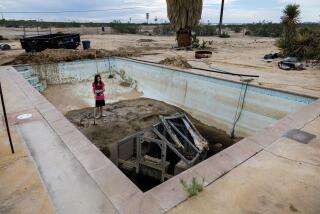Where Coping With Water Is a Way of Life
- Share via
OLIVEHURST, Calif. — As they fled the Feather River in the predawn darkness Friday, the anxious people of Olivehurst were certain of one thing: This would not be the last time they run from a flood.
In rainy years ahead--as in rainy years past--the rivers of Northern California will swell and the levees will burst, swamping the land where they plant their orchards and park their RVs and pray that when disaster strikes, they can get out in time.
It is not fun, but it is a wintertime way of life in the northern Central Valley, which is, geologically speaking, a giant basin that was bathed in wild runoff until humans arrived with their concrete dams and notions about distracting water from its natural course.
“Man has messed with Mother Nature,” said David Kessler as he packed two Rottweilers and a pet iguana into his car and prepared to abandon his Olivehurst home. “Now Mother Nature is messing back.”
One of the largest messes wrought Friday was in Olivehurst, which was beneath a spreading, 16-square-mile lake created when an earthen levee on the Feather River gave way. Flood waters were pouring through an ever-widening, 900-foot-wide gap and had crept up to rooftops by nightfall.
Elsewhere in the northern half of the state, at least a dozen major reservoirs were full or nearly so, with unprecedented releases of water pouring forth to relieve the dams. The ensuing floods demonstrate once again a truth that droughts make easy to forget: Despite an elaborate plumbing system of reservoirs, dams, levees and spillways, natural forces sometimes triumph.
“Without all these dams and reservoirs, we would be a great inland sea,” said James Bailey, a state flood specialist. “At times like this, we need to remember that.”
Managing that sea of runoff to prevent floods in the north and assure full swimming pools in the south is a delicate job--even during calm weather. Complex calculations must be made to determine how much water can safely be held in the reservoirs and how much should be released.
When heavy rains descend and runoff surges, as it did this week in historic amounts, the task gets tougher. Gathered at a nerve center in Sacramento, hydrologists and other specialists monitor minute-by-minute computer readouts of reservoir levels to decide when and if adjustments in releases should be made.
This week, managers increased releases to a historic high into the Feather River below Oroville Dam, responding to 40 inches of rainfall that has drenched the Sierra since Sunday. Critics charged that the releases caused Thursday night’s massive levee break downstream.
David N. Kennedy, director of the state Department of Water Resources, did not deny that the high water might have punched the 500-foot hole in the levee, but said there had been no choice but to let the water flow.
And even when reservoirs stop filling with rain and melted snow in the days to come, managers must release still more water to free up space for the next big storm. Already this week, the state’s major dams were perilously close to full.
“We were holding back as much as we could,” Kennedy said Friday of the reservoir behind Oroville, “but the lake was filling at an unprecedented rate. . . . In general, the system is doing what it’s supposed to do.”
While the hydrologists worked at their computers, teams of levee patrollers were out along the rivers, scouring the earthen embankments for weaknesses. Working on foot and by car, the spotters looked for geysers and for telltale “bubbles”--evidence of erosion that are often seen just before a levee breaks.
“If the water is bubbling clear, you’re in good shape,” said Jerry Bartell, a volunteer levee patrolman who was cruising embankments near Olivehurst in his Bronco on Thursday night. “But if it’s muddy, that means it’s spewing dirt from beneath the levee.
“If you see that,” Bartell said with a grin, “run.”
Levees are the Maginot Line in the water management system, stretching for miles along rivers that at peak flows would otherwise meander onto farm fields and subdivisions.
The region’s earliest levees were built of sand dredged from the river and piled high on the bank--where it would often melt away with the next high flow. In those days, flood control was typically a solo pursuit.
“One farmer would build a levee to protect his land, and that would divert water onto the next guy’s property downstream,” said Jim Taylor of the U.S. Army Corps of Engineers. In the 1920s, “people agreed to get together and build levees that protected everybody,” and an elaborate flood-control system was born.
Today’s levees are a patchwork of original, reinforced structures and newer banks carefully engineered with the finest design and materials.
To the chagrin of authorities, flood control is not their only use. Partying on the levees is a favorite summer pastime for teenagers, and motorcyclists enjoy tearing up and down their steep banks--making them vulnerable to failure.
The ramparts are also popular among gophers and ground squirrels, whose Byzantine burrows are often a key culprit in levee breaks.
Hydrologists say each levee has a design capacity--the amount of water it can handle safely. In flood conditions, however, brimming reservoirs sometimes spill more water than downstream rivers can handle, thus straining the levees.
That may be what happened on the Feather, which was hit with a triple whammy of rain, spillover from Oroville Dam and a powerful flow from its tributaries, especially the Yuba River. The levee was scheduled for reinforcement under a rehabilitation program authorized by Congress after 1986 floods, which caused $1.5 billion in damage and killed 15 people.
For those who live in their shadow, levees are both friends and foes. Karen Cervantes lived through the 1986 flood--which sent water up to the eaves of her Linda home--and was evacuated from her Olivehurst house this time, with her four children in tow.
“It’s scary,” she said Friday at a Red Cross shelter. “It’s going to take me some time to trust that levee again.”
Times staff writer Carl Ingram in Sacramento contributed to this story.
More to Read
Sign up for Essential California
The most important California stories and recommendations in your inbox every morning.
You may occasionally receive promotional content from the Los Angeles Times.










